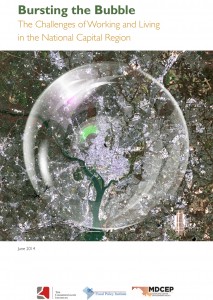Living in the national capital region looks like it has its advantages. Employment levels are back to where they were before the recession. The unemployment rate is far lower than that of the country as a whole. Incomes are high, especially for highly educated workers. From outside this bubble, things look pretty good.
 However, the bubble obscures a troubling story for many residents of the region.
However, the bubble obscures a troubling story for many residents of the region.
Income inequality is growing. Employment levels for people without a college education are far lower than before the recession. Unemployment rates for several groups of workers, including those without a college degree, remain high. Black workers and young workers were particularly hard hit by the recession, even when compared to other area residents with similar education levels. The high cost of living in the region is pushing many families to spend more than they can afford on housing, while others trade more affordable housing for long and expensive commutes.
The region has many successes worth celebrating. But broadly shared prosperity is not one of them. The region’s policymakers need to address the challenges facing those who are struggling to keep their foothold in the economy. This includes ensuring all workers in the region have the skills and credentials needed by employers for current and future jobs, taking steps to make sure all working adults have enough income to support their families, and ensuring availability of affordable housing options with access to good jobs (full recommendations are available in the full report).
To read the full report, click here.
